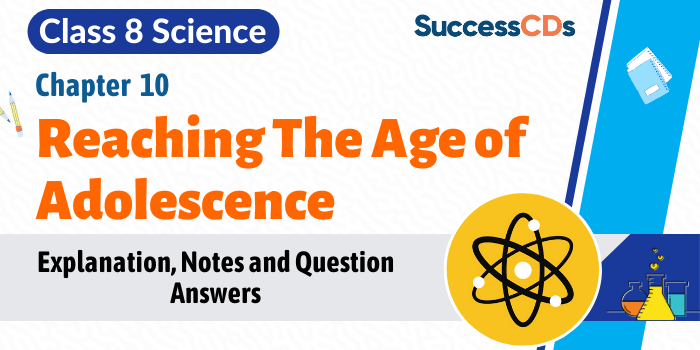
Reaching the age of adolescence Class 8 Science Chapter 10 as per NCERT Book used in CBSE and other Schools. The lesson covers the complete explanation of class 8 Chapter 10 Reaching the age of adolescence. Topics covered are puberty, secondary sexual characters, endocrine glands, hormones and their secretions. The lesson covers all important questions and NCERT solutions to book questions have also been provided for convenience of the students.
| different stages of life | endocrine glands |
| puberty | hormones |
| exocrine glands | NCERT Book Solutions |
Reaching the age of adolescence Class 8 Video Explanation
Different stages of life
The stages we have are:
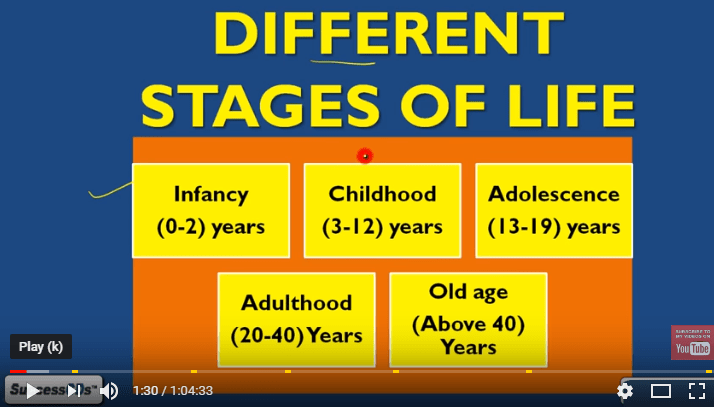
- Infancy (0-2 years)
- Childhood (3-12 years)
- Adolescence (13-19 years)
- Adulthood (20-40years)
- Old age (above 40years)
 So these all are stages of life. Now we will study this in detail-
So these all are stages of life. Now we will study this in detail-
Infancy- It is the growth period of baby from birth to 2 years.

Childhood- As you can these kids. They are in their childhood age from 3 to 12 years. This is the age of fun.

Adolescence-
This is the period of transition from childhood to adulthood from the age of 13-19 years.
As you can see these girls in the image they are in their transition period that is in their adolescence period.

Adulthood period-
This is the age between 20-40 years of age. In this age you become mature and start thinking about how to shape up your career.
 Old Age-
Old Age-
This is the age meant for resting that is the age above 40 years and the people of this age are very mature because they have crossed all the stages of life. Therefore ,they gain a lot of experience which makes them mature.
Puberty
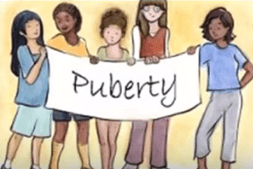 Before reading adolescence we should study about a term known as Puberty.
Before reading adolescence we should study about a term known as Puberty.
Puberty is a stage when a boy or girl attains sexual maturity. This means that sex organs start developing in both boys and girls. Boys start producing sperms and girls start producing eggs.
Q. Now when does this puberty happen?
Answer: In boys, puberty starts at the age of 14 to 15 years. In girls puberty starts early, at the age of 11 years. This means that they start producing eggs.
Q. What are the changes in teenagers that we see during puberty?
Answer: The following changes occur at puberty-
Increase in height
Change in body shape
Change in voice
Increased activity of sweat glands
Development of sex organs
Production of hormones that stimulate gametes production
Becomes mentally, emotionally mature.
Now we will study these changes in detail
-
 Increase in height-
Increase in height-
There is a sudden increase in height. During puberty, hormone secretion is very high. This signals the body to grow faster. In boys this can be seen when they are 13 years old and in girls this can be seen at 11 years of age. This sudden increase is called ‘growth spurt’. The growth never occurs equally in whole body. The parts which increase first are arms and legs.
-

 Change in Body shape-
Change in Body shape-
There are a lot of changes in body shape. Both boys and girls experience muscle growth. That is why we can differentiate between boys and girls. Let’s see this difference.
Boys- Boys show increase in muscle tissue. Body becomes muscular, shoulders become broad.
Girls- Girls have faster increase in fats tissue. The fat moves from the middle to the upper and lower body giving curvier appearance.
-
 Change in Voice-
Change in Voice-
During puberty the voice box or the larynx begins to grow. Boys develop larger voice box known as Adam’s apple. In girls the larynx is hardly visible because of its small size.
-
 Increased activity of sweat glands- During teenage you must have noticed that boys and girls face the problem of acne. This happens because of increased secretion of sweat and oil glands around face which makes their skin oily and lead to pimples.
Increased activity of sweat glands- During teenage you must have noticed that boys and girls face the problem of acne. This happens because of increased secretion of sweat and oil glands around face which makes their skin oily and lead to pimples. - Development of sex organs-
In males, testis are developed which produce sperms and in girls, the developed sex organs known as ovaries start producing eggs.
So now you know the primary sexual characters.
Similarly, secondary sexual characters are also seen.
Secondary sexual characters are controlled by sex hormones. There are certain characters by which male and female is distinguished. So, what are these characters? We will now study.
 Q. In males what kind of secondary sexual organs are developed?
Q. In males what kind of secondary sexual organs are developed?
Answer: The features in Males are development of beard and moustaches. There is facial hair growth and development of deep voice, shoulders become broad and height is increased.
Q. In Females what characters are developed?
Answer: There is development of mammary glands that is development of milk producing glands. Facial hair growth, they develop a shrill voice, starting of menstrual cycle which is vaginal bleeding and widening of pelvic area.
Glands-
Glands are formed of group of cells which can secrete. There are two types of glands which are as follows:
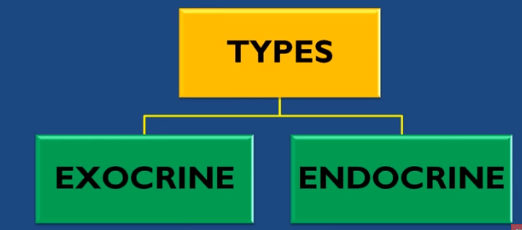
Exocrine gland
They have ducts and they produce enzymes.
Enzymes are a substance which helps in different types of reactions in body. Salivary amylase is an enzyme which helps in digesting carbohydrate. Liver is the largest exocrine gland.
Endocrine gland
These glands do not have ducts. They secrete hormones. The study of endocrine glands is known as endocrinology.
So first of all let’s see
Difference between endocrine and exocrine glands.
| Exocrine Glands | Endocrine Glands |
| With ducts | Are ductless |
| Secrete Enzyme | Secrete Hormones |
| Example: Liver | Example: Thyroid gland |
The question here is –
Q. How endocrine glands work without duct?
Answer: It takes help of blood to reach the different organs as blood is the connective tissue.
There are a number of both endocrine and exocrine glands but Pancreas is the only gland which is both endocrine and exocrine.
So, now we will study hormones.
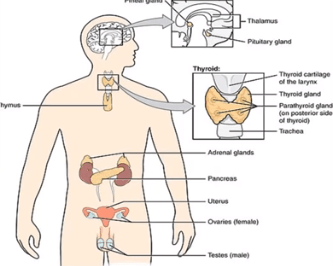 Hormones
Hormones
Hormones are the chemicals that control certain mechanism in our body secreted by endocrine glands such as Pituitary gland which is in brain also known as master gland. Then we have thyroid gland in our throat. There is a gland known as adrenal gland present above kidneys. Then we have pancreas which is a leaf like structure which is both exocrine and endocrine gland. Moving down, we have ovaries present in females and testes present in males.
Now we will study characteristics of hormones:
- They act on specific target organ
- Reach target organ through blood
- They are secreted in very small amounts
Q. What are the different types of endocrine glands?
Answer: The different endocrine glands are as follows –
- Pituitary gland- It is present in head
- Thyroid gland- it is located in neck. A gland joined with this is parathyroid gland.
- Adrenal gland- a cap like structure above kidney
- Pancreas- a leaf like gland
- Testes- Present only in boys
- Ovaries- Present only in girls
 Now lets study these glands in detail:
Now lets study these glands in detail:
Pituitary gland- It is located in brain. It is also called master gland because it controls like a master and it controls the functioning of other glands.
It secretes growth hormones which control the development of bones and muscles. If there is excessive secretion (hyper secretion) of GH it causes gigantism and on the other hand if it secrets less (hypo secretion) it will cause dwarfism.
 Thyroid Gland- It is located in the neck. It secretes thyroxin which controls metabolism of carbohydrate, protein & fat. If there is improper secretion of thyroid gland it leads to disease.
Thyroid Gland- It is located in the neck. It secretes thyroxin which controls metabolism of carbohydrate, protein & fat. If there is improper secretion of thyroid gland it leads to disease.
In adults it is Goitre- this is enlargement of thyroid gland.

In children it is Cretinism- The symptoms of this are as follows:
- Stunted growth
- Short fingers
- Deformed bones and teeth
- Abdomen gets pot bellied
- Mentally retarded
So there is overall disturbance in growth.
Pancreas- It is located below the stomach. Some of its cells are endocrine and some cells are exocrine. It secretes two types of hormones. They are as follows:
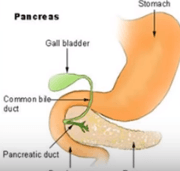 Insulin- Insulin lowers blood glucose level. So it controls sugar level in our body.
Insulin- Insulin lowers blood glucose level. So it controls sugar level in our body.
Glucagon- Increases blood glucose level
To maintain the right glucose level, it increases and decreases the glucose level and that is why it is also called Antagonistic hormone.
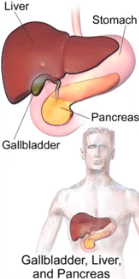 Antagonistic means a hormone which performs same function but in opposite direction.
Antagonistic means a hormone which performs same function but in opposite direction.
If there is deficiency of insulin, then the glucose level of blood will increase this will cause Diabetes mellitus. In this disease the person becomes weak and sugar crystal can be seen in the urine.
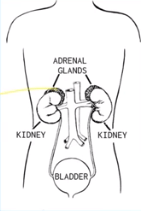 Adrenal Gland- The word ‘Renal’ is related with kidney. So the adrenal glands are located on top of kidneys which are a cap like structure. They secrete adrenalin that regulates heart beat, breathing rate, blood pressure, etc. So, we can say that adrenalin is a hormone which prepares our body for action as it controls our feelings. It is also known as emergency hormone.
Adrenal Gland- The word ‘Renal’ is related with kidney. So the adrenal glands are located on top of kidneys which are a cap like structure. They secrete adrenalin that regulates heart beat, breathing rate, blood pressure, etc. So, we can say that adrenalin is a hormone which prepares our body for action as it controls our feelings. It is also known as emergency hormone.
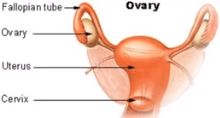 Ovaries- These glands are present only in females. They secrete estrogen which is a sex hormone. Ovaries help in egg production and development of secondary sexual characters in females.
Ovaries- These glands are present only in females. They secrete estrogen which is a sex hormone. Ovaries help in egg production and development of secondary sexual characters in females.
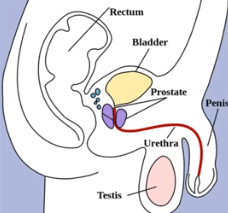 Testis- These glands are present in males. The main function is to produce male sex hormone known as testosterone. It helps in sperm production and development of secondary sexual characters in males.
Testis- These glands are present in males. The main function is to produce male sex hormone known as testosterone. It helps in sperm production and development of secondary sexual characters in males.
NCERT Book Solutions
Question/ Answer
Q. What is the term used for secretions of endocrine glands responsible for the changes taking place in the body?
Ans- The chemical substances known as hormones are secreted by endocrine glands. They are responsible for changes taking place in the body.
Q. Define adolescence?
Ans- Adolescence is the stage when the body undergoes changes, leading to reproductive maturity. It begins around the age of 11 and lasts till 19 years of age. This period of life is known as adolescence.
Q. What is menstruation? Explain.
Ans- Menstruation is the process of the shedding of the uterine lining on a regular monthly basis in woman. This starts during the age of adolescence. During menstruation the uterus wall along with blood vessels break off. This causes blood to come out and a new wall of uterus is formed. Menstruation generally continues for 4 or 5 days.
Q. List changes in the body that take place at puberty?
Ans-Changes which can be seen at puberty are as follows:
- Sudden increase in height and weight.
- Broadening of shoulders and widening of chest in boys. In girls, the region above and below the waist becomes curvier.
- In boys the larynx becomes prominent the vocal cords become thicker making their voice hoarse.
- Appearance of facial hair
- Excessive secretion of oil leads to acne
- In boys testis start producing sperms and in girls ovaries enlarge and start producing eggs.
Q. Prepare a table having two columns depicting names of endocrine glands and hormones secreted by them?
Answer:
| Endocrine glands | Hormones |
| Testis | Testosterone |
| Ovary | Oestrogen |
| Thyroid | Thyroxin |
| Adrenal | Adrenalin |
| Pancreas | Insulin |
| Pituitary | Growth hormone |
Q. What are sex hormones? Why are they named so? State their functions.
Answer: Sex hormones are those hormones that control the development of secondary sexual characteristics and also the proper function of sex organs.
Function of sex hormones:
Testosterone: This causes secondary sexual characters in boys such as the growth of a beard, hoarse voice, development of reproductive organs etc.
Oestrogen: This is responsible for the development of secondary sexual characters in females such as curvier body, development of reproductive organs, etc.
Multiple Choice Questions
1. Adolescents should be careful about what they eat because
a) Proper diet develops their brains
b) Proper diet is needed for the rapid growth taking place in their body
c) Adolescents feel hungry all the time.
d) Taste buds are well developed in teenagers
Ans- Proper diet is needed for the rapid growth taking place in their body.
2. Reproductive age in women starts when their
a) Menstruation starts.
b) Breasts start developing
c) Bodyweight increases
d) Height increases
Ans- Menstruation starts
3. The right meal for adolescents consist of
a) Chips, noodles, coke
b) Chapatti, dal, vegetables
c) Rice, noodles and burger
d) Vegetable cutlets, chips and lemon drink
Ans- Chapatti, dal, vegetables
Write notes on the following:
a) Adam’s apple:
Adam’s apple is the protruding part of the throat in males. It is the enlarged voice box or larynx which is visible from outside in boys during puberty. This makes their voice hoarse.
b) Secondary sexual characters:
They are the characteristics that help to differentiate between boys and girls appearance. They are as follows:
In males
- Formation of muscles in boys
- Growth of moustache and beard
- Growth of facial hair
In Females:
- Growth of facial hair
- Growth of sex organs
- Increase in the size of breast and buttocks.
c) Sex determination in an unborn baby
The sex of a baby depends upon the pair of sex chromosomes that are present in the cells of a baby. The two sex chromosomes are X and Y. Males have 23 pair of chromosomes including X or Y sexes. On the other hand females have 23 pairs of chromosomes including XX chromosomes. Therefore male gametes can be of two types:22+X or 22+ Y but the female gametes only have 22+X. Thus the sex of baby is determined by the male gamete (X or Y) that fuses with the X chromosome of the female.